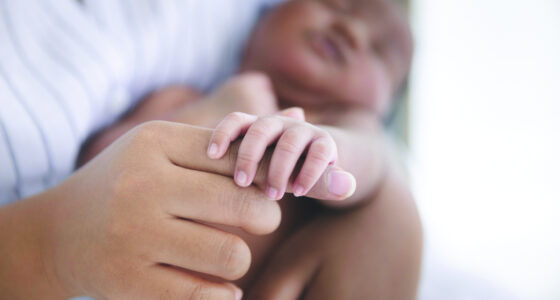
The heart performs the critical job of pumping blood to and from the lungs and throughout the body. Because its work never stops, this pump must function to meet all the body’s needs. Patients with hypoplastic left heart syndrome (HLHS) have several important structures on the heart’s left side that fail to develop properly. This occurs during fetal development and can compromise the baby’s health and even his or her survival. HLHS occurs more often in boys than girls.
What is Hypoplastic Left Heart Syndrome (HLHS)?
What is Hypoplastic Left Heart Syndrome (HLHS)?
The human heart has four chambers—the right atria and ventricle, and the left atria and ventricle. The atria are the upper chambers, and the ventricles are the lower chambers. In a healthy heart, the right and left sides of the heart work together. The right side sends blood to the lungs, where it picks up oxygen. The blood returns to the left side of the heart, where it is pumped into the aorta and circulates through the entire body.
In babies with HLHS, the left atria, mitral valve, left ventricle, aortic valve and the aorta are so poorly formed that the left side of the heart cannot do its job of pumping blood to the body. This means the right side of the heart must also perform the work of the left side to ensure blood reaches both the lungs and the body. While the heart may function this way for a short time (days), it cannot sustain this workload forever.
During fetal development, two connections exist between the right and left sides of the heart. These openings are the ductus arteriosus (a small vessel that connects the pulmonary artery to the aorta) and the foramen ovale (PFO) or atrial septal defect (ASD) - a hole between the right and left atrium. During the first hours and days of life, oxygen-rich blood can mix through these openings in a child born with HLHS. However, when these holes close naturally in the days after birth, it becomes difficult for oxygenated blood to reach the body, and the baby will begin to show symptoms.
When a baby does not have a PFO or ASD, the effects of HLHS are more serious. In these cases, deliveries must be carefully planned because infants require immediate attention by expert cardiologists or surgeons at birth. Maternal fetal medicine specialists, pediatric heart surgeons and pediatric cardiologists at Riley Children's work as a team to coordinate care for mothers and babies in an advanced facility that places operating rooms side-by-side with delivery rooms.

What causes HLHS?
Researchers have not yet discovered the cause of HLHS. Families that have one child with HLHS also have a higher risk of having another child with the same condition. Given the genetic link to this condition, some families choose to better understand their risk through genetic counseling. Expert doctors and genetic counselors in our Cardiovascular Genetics Program can work with your whole family to evaluate and screen for inherited cardiovascular disease.
What are the signs and symptoms of HLHS?
Babies with HLHS show signs or symptoms at birth or shortly after. Doctors and parents may notice:
- Lethargy, drowsiness or inactivity
- Cold extremities
- Respiratory distress, such as rapid or difficult breathing
- Poor ability to feed
- Pounding heart
- Blue or gray coloring (cyanosis)
How is Hypoplastic Left Heart Syndrome Diagnosed?
How is Hypoplastic Left Heart Syndrome Diagnosed?
HLHS can be diagnosed before birth during the second trimester of pregnancy with a routine prenatal ultrasound or a fetal echocardiogram. A fetal echocardiogram is especially helpful because it provides details about how the heart functions and other associated heart abnormalities, such as vein anomalies or a heart located on the wrong side of chest.
After your baby is born, a heart murmur or blue/gray skin may cause your baby’s physician to suggest further testing. A definitive diagnosis can be made with an echocardiogram.
How is HLHS Treated?
How is HLHS Treated?
Hypoplastic left heart syndrome surgery
All babies born with HLHS require surgery. Until your baby is stable enough for surgery, the condition can be managed in numerous ways. Medications can make it easier for blood to flow by keeping the ductus arteriosus open and balance the blood flowing to the lungs and the body. A ventilator can give your baby adequate oxygen. Intravenous fluids and good nutrition help babies gain weight and get ready for surgery.
Another procedure, an atrial septostomy, may be necessary if your baby’s foramen ovale (PFO) has closed or it is not present at birth. This procedure creates an opening between the atria. If your baby is also born with an atrial septal defect, this procedure may be unnecessary.
Babies with HLHS typically require three reconstructive surgeries:
- Norwood procedure
- Hemi-Fontan or bi-directional Glenn procedure
- Fontan procedure
These surgeries help to improve the functioning of your child's heart and ensure there is sufficient blood flow to the entire body. These surgeries take place periodically or in 'stages' between birth and age 3-4 years. Your child will also have cardiac catheterization procedures to evaluate the heart function before proceeding to the next staged procedure. Learn more about staged reconstructive surgery.
Heart transplant
A heart transplant may also be an option for children with a HLHS heart. Riley Children's is one of only 30 plus hospitals in the nation that is certified to perform heart transplant. Our heart surgeons are expertly prepared to assist families as they progress through this treatment and the uncertainties of this rare and life-threatening condition.
Post-surgery care
Although these surgeries are helpful, they are not a complete cure, and children can experience some problems afterwards. They may have heart rhythm disturbances or be overly tired after physical activity. Therefore, exercise should be done cautiously after evaluation by a cardiologist who specializes in congenital heart defects. Other serious problems that may occur post-surgery include:
- Blood clots, which can cause pulmonary embolism or stroke
- Abnormal fluid build-up in the legs, feet, abdomen or lungs
- Developmental problems
- Need for additional surgeries or heart transplant
- Feeding issues
When your child becomes an adult, they should seek follow-up care from a cardiologist who specializes in caring for adults with congenital heart disease. Our Adults with Congenital Heart Disease Program works to help patients transition to adult care with cardiologists from Indiana University Health.
Key Points to Remember
Key Points to Remember
- HLHS is a congenital heart defect that occurs when the main structures on the left side of the heart fail to develop.
- Because of this defect, the right side of the heart must do double-duty for blood to circulate all through the body.
- There is no cure for HLHS, but a series of three operations, performed between birth and 3 years of age, can improve the heart’s function.
- Children with HLHS may continue to experience problems that require management by a cardiologist who specializes in congenital heart disease. Once they reach adulthood, they should seek care from a cardiologist who specializes in caring for adults with congenital heart disease.
Hypoplastic Left Heart Syndrome (HLHS) Prenatal Diagnosis Infographic
Hypoplastic Left Heart Syndrome (HLHS) Prenatal Diagnosis Infographic
Learning your baby will have HLHS may seem overwhelming. Our Fetal Center team has created an infographic to let families know and understand the process of their baby's care when they're delivered at Riley Hospital for Children at IU Health.

Support Services & Resources
Support Services & Resources
These resources can be helpful for parents and caregivers whose children are diagnosed with congenital heart defects.
We offer a broad range of supportive services to make life better for families who choose us for their children's care.
This U.S. government website includes resources to educate parents and caregivers of children with congenital heart disease. It also shares information for the growing population of adults who are living with congenital heart disease.
As part of the National Institutes of Health, the National Heart, Lung and Blood Institute advances research and understanding of heart, lung and blood diseases and shares easy-to-digest information about congenital heart defects.
Hypoplastic Left Heart Syndrome (HLHS) Research
Hypoplastic Left Heart Syndrome (HLHS) Research
Through a grant from the National Institutes of Health, researchers at the Indiana University School of Medicine are studying ways to improve the Fontan procedure—the final step in a three-part strategy currently used to treat HLHS. This research aims to design a dedicated pump that could restore normal circulatory physiology and prevent Fontan failure, which is now a common result of treatment for single ventricle heart disease.
Locations
Locations
Locations
In addition to our primary hospital location at the Academic Health Center in Indianapolis, IN, we have convenient locations to better serve our communities throughout the state.
Departments Treating This Condition
Departments Treating This Condition
Related Stories
Related Stories

Riley Children’s Health brings complex heart care home for patients and their families
An early adopter of cardiovascular home monitoring through the National Pediatric Cardiology Quality Improvement Collaborative (NIP-QIC), Riley Children’s Health is Indiana’s only pediatric health...
Continue reading
#AmazingAva goes home with a new heart
After 579 days at Riley, this dragon-loving, Pokemon-playing 10-year-old walks out of the Heart Center with the gift of life.
Continue reading



